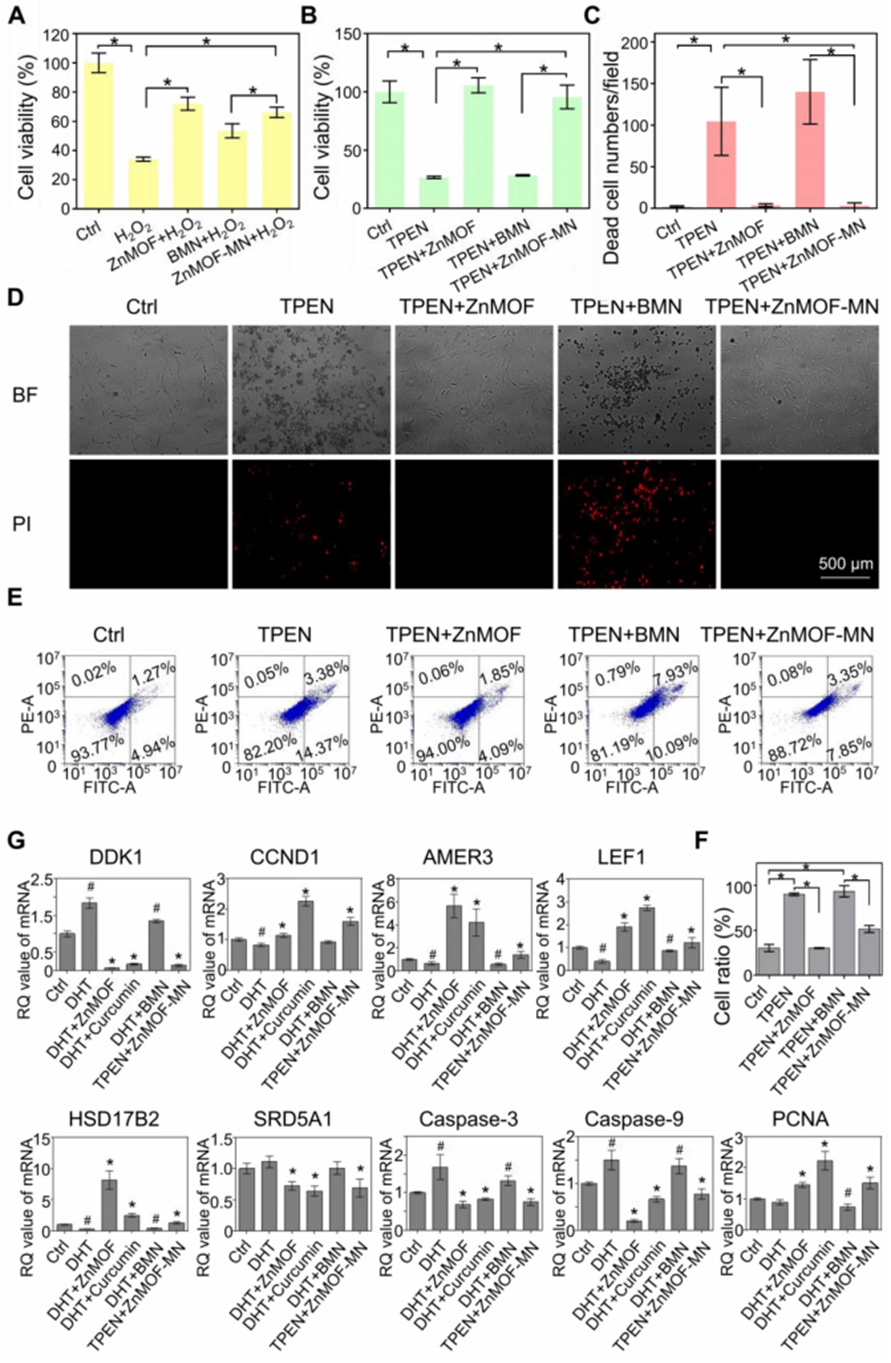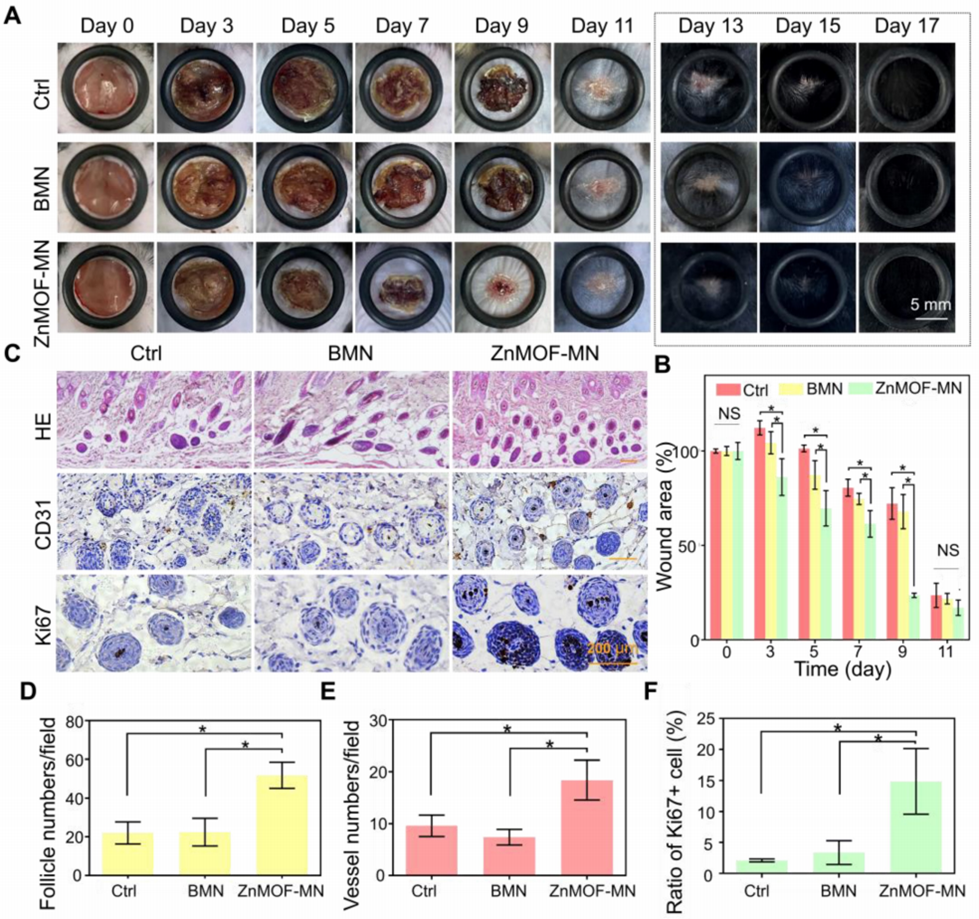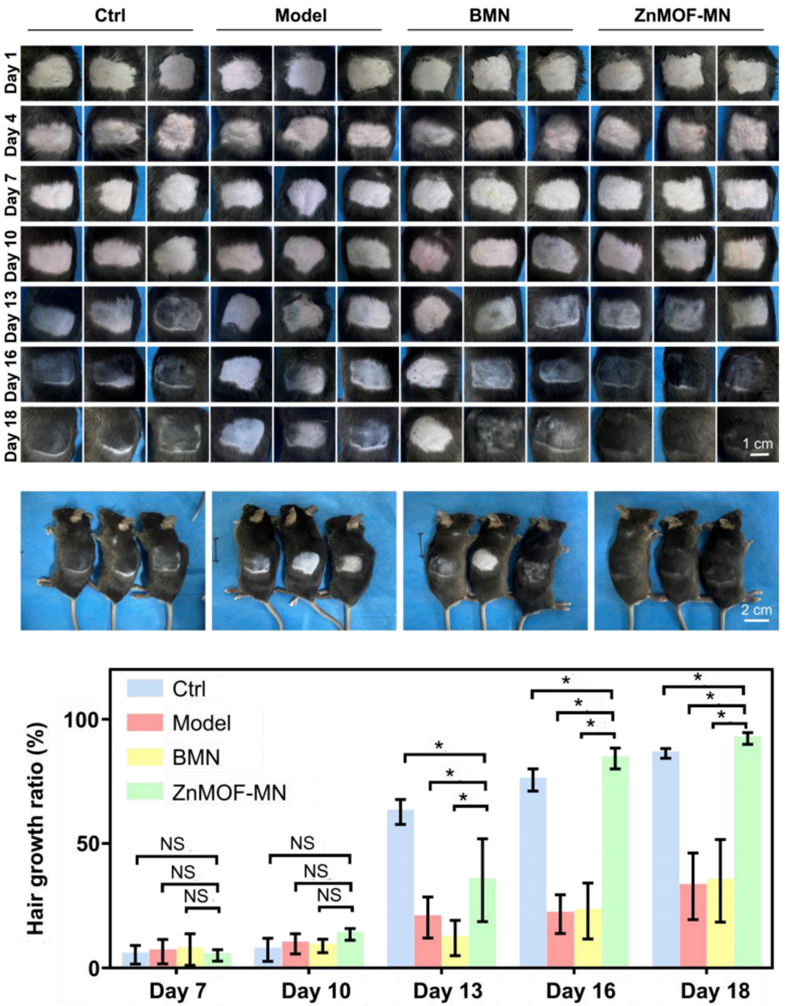Editor: Tiffany
A new microneedle patch delivering a curcumin-zinc framework has shown promising results in promoting hair growth by simultaneously addressing oxidative stress, zinc deficiency, and hormonal factors in hair loss.
Highlights
- Research Question:
What is an effective way to treat hair loss by targeting its multifactorial causes, including oxidative stress, zinc deficiency, and hormonal imbalances? - Research Difficulties:
Hair loss is driven by complex mechanisms, and current treatments often focus on single targets, have limited efficacy, and face challenges in drug delivery to the dermal layer. - Key Findings:
The study demonstrated that the ZnMOF-MN patch effectively delivers curcumin and zinc to the dermal layer, protects hair follicle cells from oxidative stress and zinc deficiency, reverses the effects of DHT, and promotes hair growth in animal models of wound healing and androgenic alopecia. - Innovative Aspects:
The combination of curcumin and zinc in a metal-organic framework (ZnMOF) and the use of a gamma-polyglutamic acid microneedle patch (ZnMOF-MN) for transdermal delivery represent novel approaches in treating hair loss. - Importance of the Study:
This research offers a comprehensive solution for hair loss by addressing multiple underlying causes simultaneously, potentially improving treatment efficacy and patient outcomes.
Understanding Hair Loss: A Complex Condition with Limited Treatment Options
Hair loss, medically termed alopecia, is a widespread condition that affects a substantial portion of the population. According to research, up to 85% of males and 40% of females experience hair-related issues at some point in their lives. This condition can lead to significant psychological distress, impacting self-esteem and quality of life. The primary symptom of alopecia is the thinning or complete loss of hair, which can present in various forms depending on the underlying cause. Common types include androgenic alopecia, characterized by pattern baldness often linked to hormonal factors; telogen effluvium, a temporary shedding of hair due to stress or illness; and alopecia areata, an autoimmune condition resulting in patchy hair loss.
The mechanisms driving hair loss are complex and multifactorial. Oxidative stress, caused by an imbalance of free radicals and antioxidants, damages hair follicle cells and impairs growth. Nutrient deficiencies, particularly of zinc, weaken hair structure and follicle health, as zinc is essential for cell proliferation and repair. In androgenic alopecia, hormonal factors play a critical role, with dihydrotestosterone (DHT)—a derivative of testosterone—inhibiting hair follicle activity and shrinking follicles over time. These combined factors make hair loss a challenging condition to treat effectively.
Current treatments aim to slow hair loss or stimulate regrowth, but they come with limitations. Minoxidil, a topical solution, is widely used to promote hair growth, yet its efficacy varies among individuals, and it may cause side effects such as scalp irritation or unwanted facial hair growth. Zinc supplementation is another approach, addressing deficiencies that contribute to hair loss, but it often fails to provide sufficient therapeutic impact when used alone. A major hurdle in these treatments is the difficulty of delivering active compounds past the skin’s natural barrier to reach the hair follicles in the dermal layer, limiting their overall effectiveness.
Developing a Multifunctional Treatment for Hair Loss
Recognizing the challenges posed by the multifactorial nature of hair loss and the shortcomings of existing therapies, a team of researchers set out to develop an innovative treatment. The study, led by Xiansong Wang and Wei Liu from the University School of Medicine in Shanghai, China, was published in the journal Theranostics in 2023. Their objective was to create a novel transdermal delivery system capable of addressing multiple mechanisms of hair loss simultaneously. Specifically, they developed a curcumin-zinc metal-organic framework (ZnMOF) encapsulated within a gamma-polyglutamic acid microneedle patch (ZnMOF-MN). This approach aimed to deliver curcumin, a potent antioxidant, and zinc, a crucial nutrient, directly to the dermal layer, targeting oxidative stress, zinc deficiency, and hormonal factors like DHT in a single therapy.
The research sought to overcome the limitations of conventional treatments by enhancing drug delivery and bioavailability. By using microneedles, the team aimed to bypass the skin barrier painlessly and efficiently, ensuring that the therapeutic agents reached the hair follicles. This study represents a significant step toward a more comprehensive and effective solution for various types of alopecia.
Innovative Microneedle Patch: From Lab to Animal Models
The development and evaluation of ZnMOF-MN involved a rigorous experimental process, conducted in multiple stages:
- Synthesis of ZnMOF:
Curcumin and zinc ions were chemically reacted to form ZnMOF nanoparticles, combining the antioxidant properties of curcumin with the structural and nutritional benefits of zinc. - Characterization of ZnMOF:
The nanoparticles underwent detailed analysis using techniques such as scanning electron microscopy (SEM), dynamic light scattering (DLS), elemental mapping, and X-ray diffraction (XRD). These tests confirmed the nanoparticles’ size, structure, and composition, ensuring their suitability for therapeutic use. - Fabrication of ZnMOF-MN:
The ZnMOF nanoparticles were encapsulated into gamma-polyglutamic acid, a biocompatible material, to create soluble microneedle patches. This step integrated the active compounds into a delivery system designed to penetrate the skin. - Characterization of ZnMOF-MN:
The microneedle patches were assessed for morphology, hygroscopicity, and release profile. Results showed that the patches could effectively penetrate the skin and release ZnMOF in a controlled manner, optimizing delivery to the target area. - In vitro Studies:
Experiments were conducted on mouse dermal papilla cells (DPCs), which are critical for hair follicle growth, to evaluate ZnMOF’s effects under conditions mimicking hair loss triggers. - In vivo Studies:
Two mouse models were used: a wound healing model and an androgenic alopecia model in C57BL/6 mice, to test the treatment’s efficacy in living organisms.
Key Experiments and Findings
- In vitro Studies on DPCs:
- Procedure: DPCs were exposed to hydrogen peroxide (to induce oxidative stress), a zinc chelator (TPEN) (to simulate zinc deficiency), and DHT (to mimic androgenic alopecia conditions). ZnMOF was then applied to assess its protective effects.
- Results: ZnMOF significantly enhanced cell viability under oxidative stress, reduced programmed cell death (apoptosis) in zinc-deficient conditions, and counteracted DHT’s inhibitory effects on cell proliferation and gene expression related to hair growth.
- New Finding: ZnMOF demonstrates a multifunctional protective role, shielding hair follicle cells from diverse stressors associated with alopecia.

Figure 1. In vitro anti-oxidant, anti-apoptosis, and anti-androgen capacities of ZnMOF-MN.
- In vivo Wound Healing Model:
- Procedure: Full-thickness skin wounds were created on mice, and ZnMOF-MN patches were applied to the affected areas.
- Results: The treatment accelerated wound closure and increased the density of hair follicles in the healed skin compared to untreated controls.
- New Finding: ZnMOF-MN not only aids wound healing but also promotes hair regrowth in damaged tissue, suggesting potential applications for hair loss caused by trauma or surgical procedures.

Figure 2. In vivo hair growth evaluation and histological study in C57BL/6 mice of wound healing models.
- In vivo Androgenic Alopecia Model:
- Procedure: Mice were treated with DHT to induce hair loss similar to androgenic alopecia, followed by application of ZnMOF-MN.
- Results: The treated mice exhibited significant hair regrowth compared to the control group, with improved follicle health and density.
- New Finding: ZnMOF-MN effectively reverses hair loss in an androgenic alopecia model, addressing one of the most common and persistent forms of alopecia.

Figure 3. In vivo hair growth evaluation in C57BL/6 mice of androgenic alopecia models.
A Promising Step Towards Comprehensive Hair Loss Therapy
This study reveals that ZnMOF-MN is a highly promising treatment for hair loss, tackling multiple underlying causes through a single delivery system. By combining curcumin and zinc within a metal-organic framework, the therapy combats oxidative stress, corrects zinc deficiency, and neutralizes the detrimental effects of DHT. The use of microneedle patches enhances the treatment’s effectiveness by ensuring precise and efficient delivery of these compounds to the dermal layer, where hair follicles reside. In experimental models, ZnMOF-MN promoted hair growth in both wound healing and androgenic alopecia contexts, demonstrating its versatility.
The innovation lies in its multifunctional approach and advanced delivery method. Unlike traditional treatments such as minoxidil or zinc supplements, which target single aspects of hair loss and struggle with delivery challenges, ZnMOF-MN offers a comprehensive solution. The microneedle technology provides a painless, minimally invasive way to bypass the skin barrier, improving the bioavailability of the active ingredients. These findings highlight the significance of this research, positioning ZnMOF-MN as a potential game-changer in the field of hair loss treatment.
Reference:
Yang, Yating, et al. “Curcumin-zinc framework encapsulated microneedle patch for promoting hair growth.” Theranostics 13.11 (2023): 3675.
